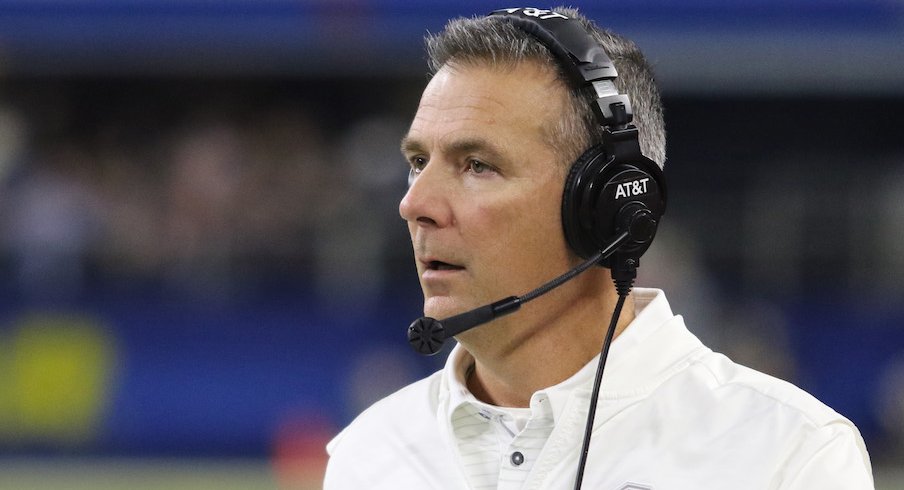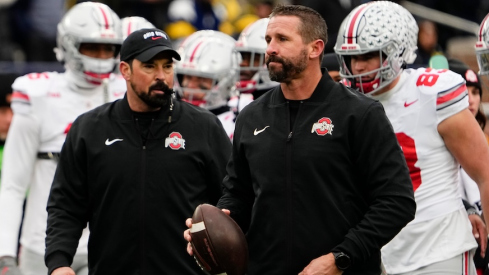For the past 20 years, Urban Meyer has dealt with an arachnoid cyst in his brain and recent flare-ups that have contributed to speculation that this could be Meyer’s last season at Ohio State.
Meyer opened up about his condition on Tuesday, admitting that the enlarged cyst has caused him severe pain headaches, but he plans to remain the head coach at Ohio State for as long as he can.
While we don’t know much about Meyer’s specific condition, knowing background information on congenital arachnoid cysts can give some insight into what Meyer is dealing with.
What is an arachnoid cyst?
Arachnoid cysts are benign cysts that occur in arachnoid layer of the tissue surrounding the brain and are the most common type of brain cyst, according to Johns Hopkins Medicine.
Oftentimes, including in Meyer’s case, the cysts are congenital, simply meaning he’s had it since birth.
The cysts are not tumors, but rather fluid-filled sacs that can become enlarged for a number of reasons which could cause headaches resulting from pressure.
What are the symptoms of arachnoid cysts?
Arachnoid cysts sometimes do not cause any symptoms at all, but that was not the case with Meyer, who became aware of the cyst in his mid-30s.
Since being diagnosed with the cyst, Meyer has dealt with off-and-on severe headaches that have flared up in the past couple years. That is a symptom of the cyst that resides in the left side of his brain.
The other typical symptoms of arachnoid cysts include nausea and vomiting, seizures, hearing and visual disturbances, vertigo and difficulties with balance and walking, according to the Cleveland Clinic. Johns Hopkins Medicine lists lethargy, including excessive fatigue and low energy, as a symptom.
Meyer has not referenced dealing with any symptoms other than headaches.
Symptoms of the cyst typically arise before a person is 20 years old. The cyst’s size and location play a role in determining the severity of the symptoms. According to UCLA Health, symptoms of cysts typically are mild, though the cysts might be large.
How is an arachnoid cyst treated?
In most cases, arachnoid cysts are stable and do not require treatment. But in some cases, the fluid may need to drained, sometimes periodically, in order to relieve the pressure.
This can be done through several options. One option is craniotomy, which involves making an opening in the skull to create openings in the cyst wall and ensure normal flow of cerebrospinal fluid.
Another option is shunting, which involves inserting a tube, which remains in place, into the cyst to allow the fluid to drain and be absorbed elsewhere in the body.
The treatment – or lack thereof – is determined by a number of factors including the severity of the symptoms and the exact anatomical location of the cyst.
What we know about Urban Meyer’s cyst
Meyer was diagnosed with the cyst in 1998. Over the next 15 years, Meyer said, the cyst “surfaced” a couple times. Then, in 2014, he underwent brain surgery to deal with the symptoms of the cyst after having headaches for almost a month. At the time, he said he felt “good, not great” and noted he had to manage it.
“The complex surgery removed a subdural fluid collection caused by the cyst to relieve increased intracranial pressure,” Dr. Andrew Thomas, Meyer’s personal physician, told Pete Thamel of Yahoo! Sports.
In recent years, symptoms caused by the cyst have worsened. Thomas told reporters on Tuesday that he has been working with Meyer to “monitor and manage the symptoms that have risen from his enlarged congenital arachnoid cyst.” Particularly in the past two years, Thomas said, “aggressive headaches” have “flared up.”
During Ohio State’s game against Indiana on Oct. 6, Meyer went down to his knees with a headache. The Columbus Dispatch reported sources within the football program told them Meyer has had similar incidents during practices. On Tuesday, Meyer said it does not affect his day-to-day work and he reiterated his full commitment to Ohio State.


